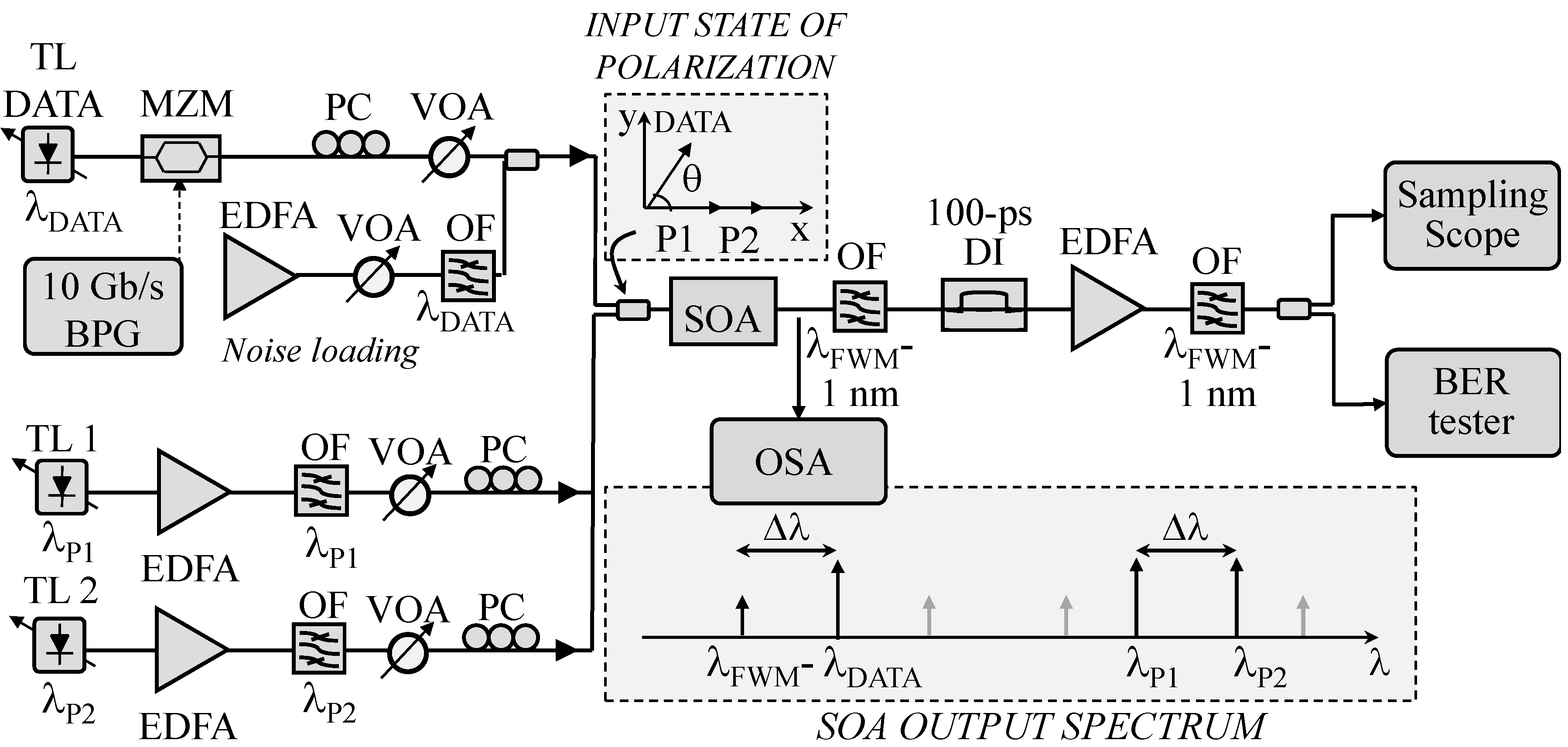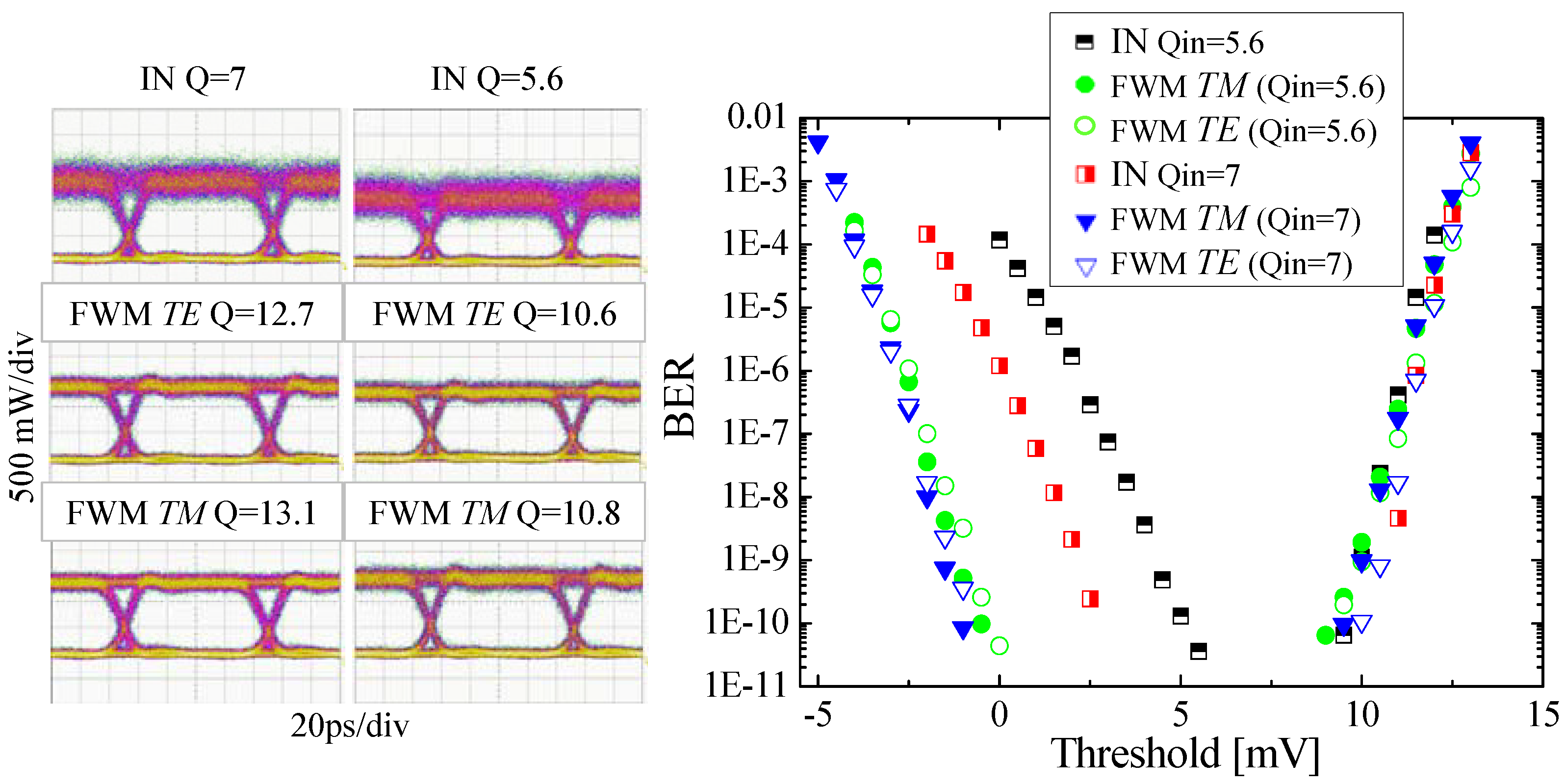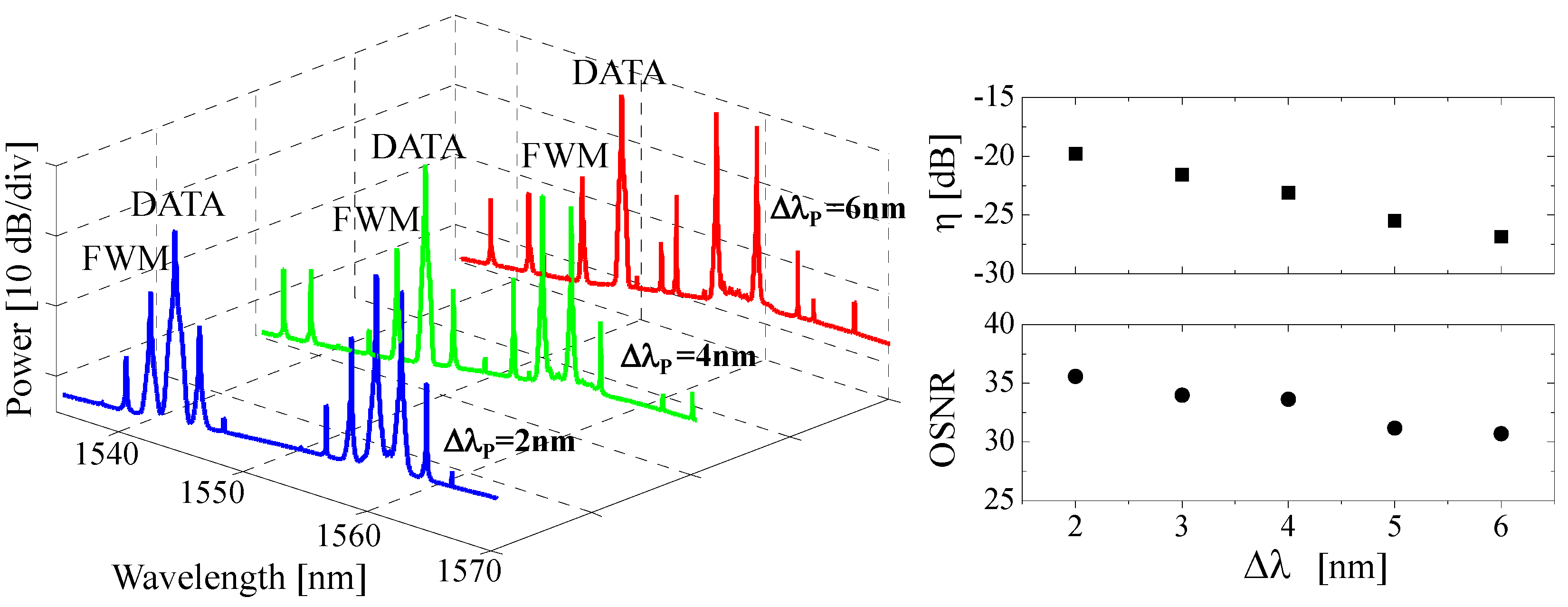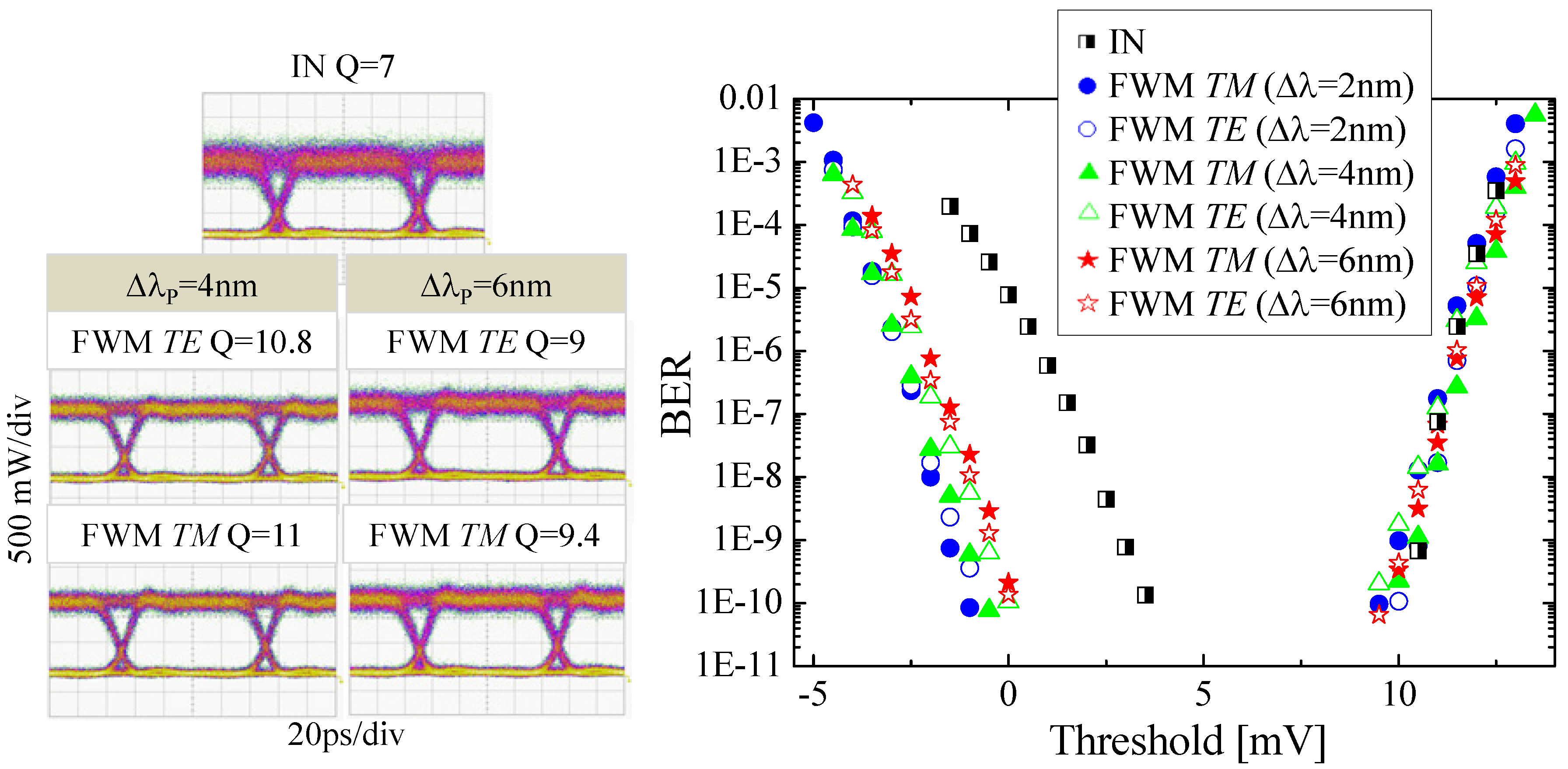Polarization-Independent All-Optical Regenerator for DPSK Data
Abstract
:1. Introduction
2. Set-Up and Principle

3. Experimental Results



4. Conclusions
Acknowledgments
Author Contributions
Conflicts of Interest
References
- Nuzman, C.; Leuthold, J.; Ryf, R.; Chandrasekhar, S.; Giles, C.R.; Neilson, D.T. Design and implementation of wavelength-flexible network nodes. J. Lightw. Technol. 2003, 21, 648–663. [Google Scholar] [CrossRef]
- Yan, L.; Willner, A.E.; Wu, X.; Yi, A.; Bogoni, A.; Chen, Z.-Y.; Jiang, H.-Y. All-optical signal processing for ultra-high speed optical systems and networks. J. Lightw. Technol. 2012, 30, 3760–3770. [Google Scholar] [CrossRef]
- Croussore, K.A.; Li, G. Phase-Regenerative Wavelength Conversion for BPSK and DPSK Signals. IEEE Photon. Technol. Lett. 2009, 21, 70–72. [Google Scholar] [CrossRef]
- Kouloumentas, C. ; Bougioukos, M.; Maziotis, A.; Avramopoulos, H. DPSK regeneration at 40 Gb/s and beyond using a fiber-Sagnac interferometer. IEEE Photon. Technol. Lett. 2010, 22, 1187–1189. [Google Scholar] [CrossRef]
- Kang, I.; Dorrer, C.; Zhang, L.; Rasras, M.; Buhl, L.; Bhardwaj, A.; Cabot, S.; Dinu, M.; Liu, X.; Cappuozzo, M.; et al. Regenerative all optical wavelength conversion of 40-Gb/s DPSK signals using semiconductor optical amplifier Mach-Zehnder interferometer. In Proceedings of the 31st European Conference on Optical Communication, Glasgow, Scotland, UK, 25–29 September 2005; Volume 6, pp. 29–30.
- Matsumoto, M. Performance improvement of phase-shift-keying signal transmission by means of optical limiters using four-wave mixing in fibers. J. Lightw. Technol. 2005, 23, 2696–2701. [Google Scholar] [CrossRef]
- Jiang, H.; Wen, H.; Han, L.-Y.; Guo, Y.-L.; Zhang, H.-Y. Amplitude regenerative characteristics of RZ-DPSK wavelength converter based on four-wave mixing in SOA. Chin. Phys. Lett. 2008, 25, 1697–1700. [Google Scholar] [CrossRef]
- Porzi, C.; Bogoni, A.; Contestabile, G. Regeneration of DPSK signals in a saturated SOA. IEEE Photon. Technol. Lett. 2012, 24, 1597–1599. [Google Scholar]
- Porzi, C.; Bogoni, A.; Contestabile, G. Regenerative wavelength conversion of DPSK signals through FWM in an SOA. IEEE Photon. Technol. Lett. 2013, 25, 175–178. [Google Scholar] [CrossRef]
- Schnabel, R.; Hilbk, U.; Hermes, T.; Meißner, P.; Helmolt, C.; Magari, K.; Raub, F.; Pieper, W.; Westphal, F.J.; Ludwig, R.; et al. Polarization insensitive frequency conversion of a 10-channel OFDM signal using four-wave-mixing in a semiconductor laser amplifier. IEEE Photon. Technol. Lett. 1994, 6, 56–58. [Google Scholar]
- Porzi, C.; Bogoni, A.; Poti, L.; Contestabile, G. Polarization and wavelength-independent time-division demultiplexing based on copolarized-pumps FWM in an SOA. IEEE Photon. Technol. Lett. 2005, 17, 633–635. [Google Scholar] [CrossRef]
- Lacey, J.P.R.; Summerfleld, M.; Madden, S.J. Tunability of polarization-insensitive wavelength converters based on four-wave mixing in semiconductor optical amplifiers. J. Lightw. Technol. 1998, 16, 2419–2427. [Google Scholar] [CrossRef]
- Zhou, J.; Park, N.; Dawson, J.W.; Vahala, K.J.; Newkirk, M.A.; Miller, B.I. Efficiency of broadband four-wave mixing wavelength conversion using semiconductor traveling-wave amplifier. IEEE Photon. Technol. Lett. 1994, 6, 50–52. [Google Scholar] [CrossRef]
- Obermann, K.; Mecozzi, A.; Mørk, J. Theory of four-wave mixing. In Photonic Devices for Telecommunications, 1st ed.; Guekos, G., Ed.; Springer: Berlin, Germany, 1999. [Google Scholar]
- Porzi, C.; Serafino, G.; Bogoni, A.; Contestabile, G. All-Optical regeneration of 40 Gb/s NRZ-DPSK signals in a single SOA. In Proceedings of the Optical Fiber Communication Conference, Anaheim, CA, USA, 17–21 March 2013; p. JW2A.55.
- Krzczanowicz, L.; Connelly, M.J. 40 Gb/s NRZ-DQPSK data all-optical wavelength conversion using four wave mixing in a bulk SOA. IEEE Photon. Technol. Lett. 2013, 25, 2439–2441. [Google Scholar]
© 2014 by the authors; licensee MDPI, Basel, Switzerland. This article is an open access article distributed under the terms and conditions of the Creative Commons Attribution license (http://creativecommons.org/licenses/by/3.0/).
Share and Cite
Vercesi, V.; Porzi, C.; Contestabile, G.; Bogoni, A. Polarization-Independent All-Optical Regenerator for DPSK Data. Photonics 2014, 1, 154-161. https://doi.org/10.3390/photonics1020154
Vercesi V, Porzi C, Contestabile G, Bogoni A. Polarization-Independent All-Optical Regenerator for DPSK Data. Photonics. 2014; 1(2):154-161. https://doi.org/10.3390/photonics1020154
Chicago/Turabian StyleVercesi, Valeria, Claudio Porzi, Giampiero Contestabile, and Antonella Bogoni. 2014. "Polarization-Independent All-Optical Regenerator for DPSK Data" Photonics 1, no. 2: 154-161. https://doi.org/10.3390/photonics1020154



